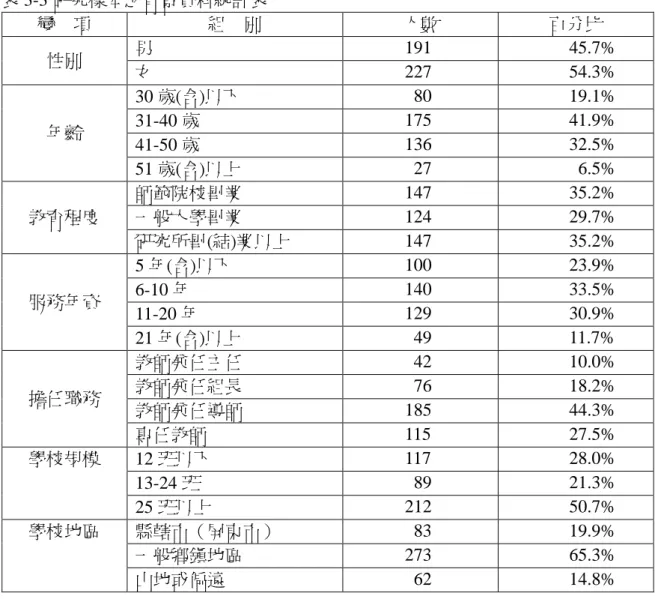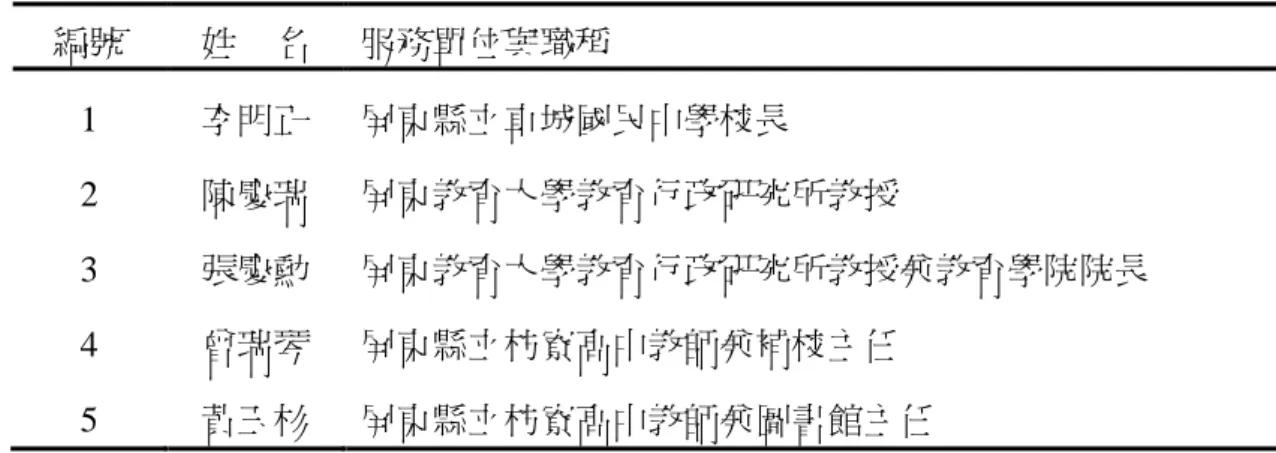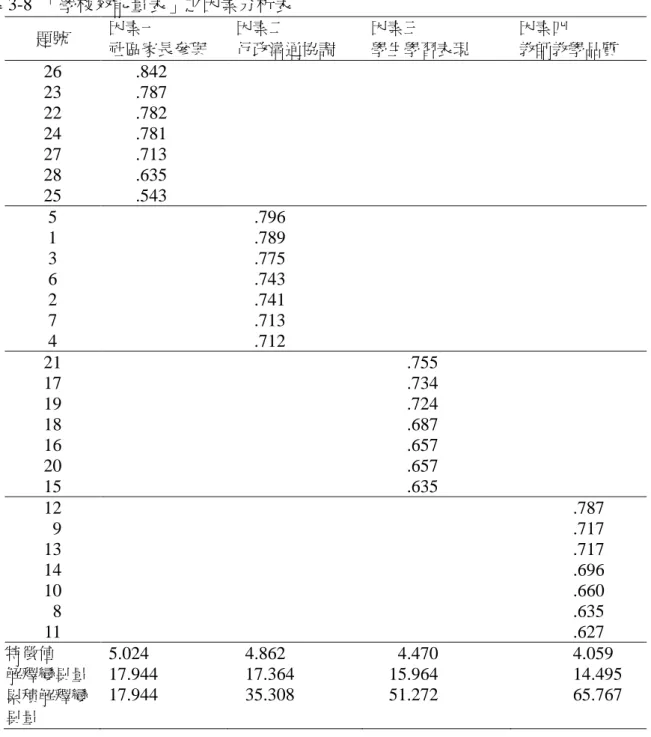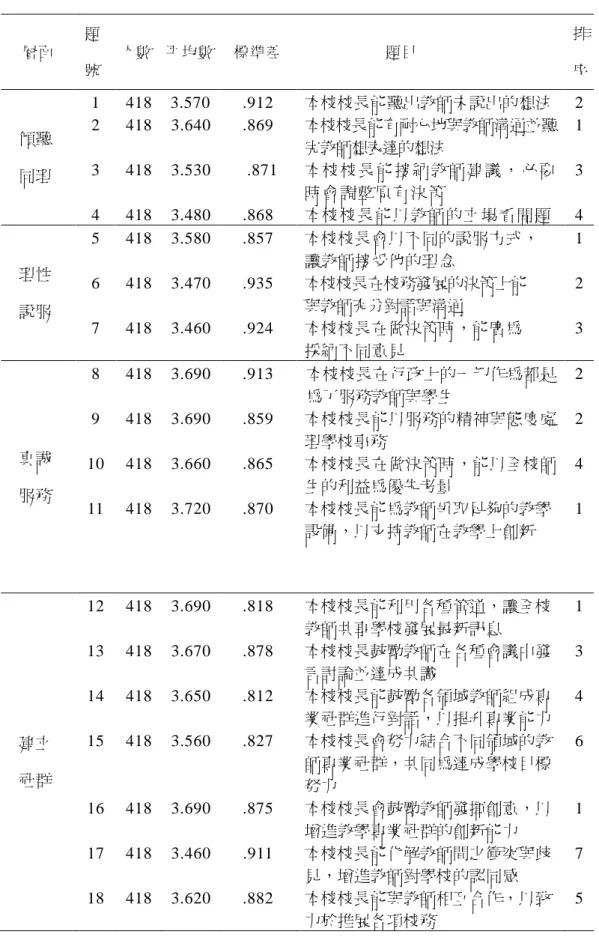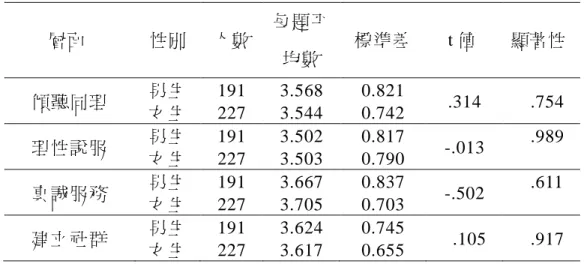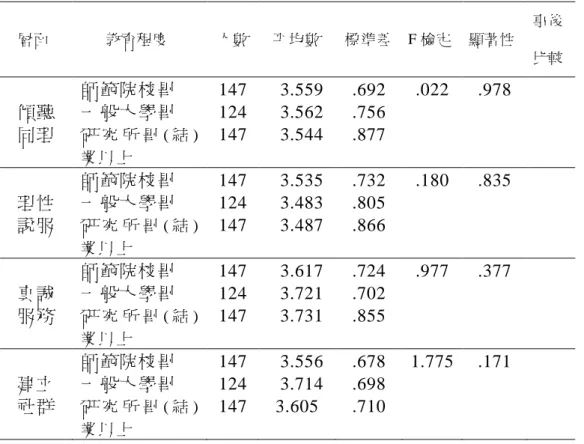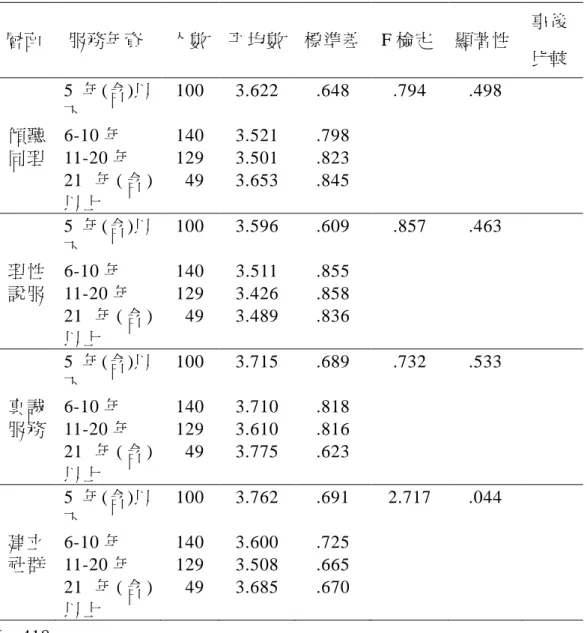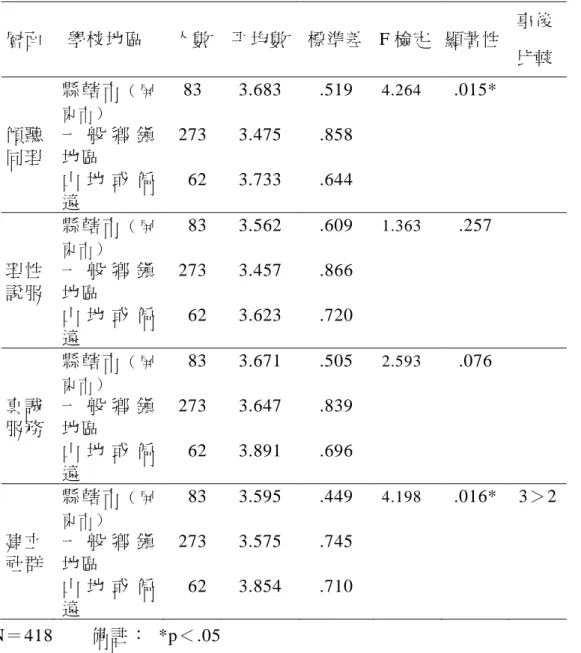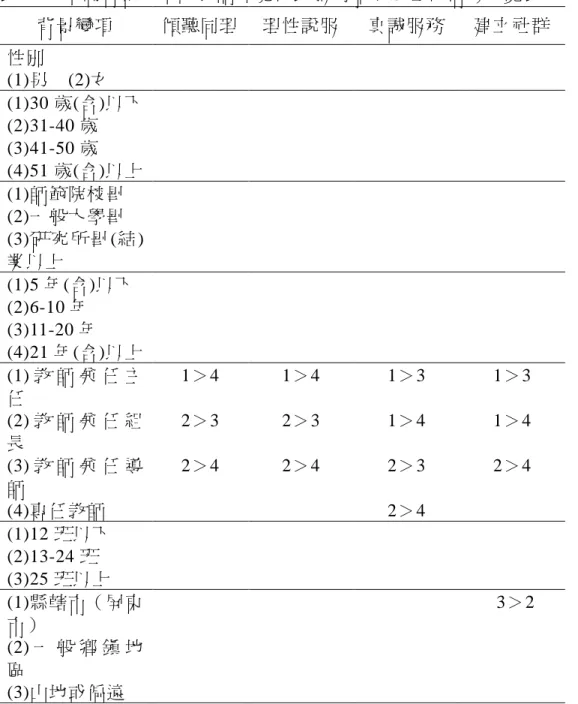國立屏東教育大學教育行政研究所碩士論文
指導教授:林官蓓 博士
屏東縣國民中學校長服務領導與學校效能關係之研究
研究生:李伊雯 撰
The Study of the Relationship between Servant Leadership of Principals
And School Effectiveness in the Junior High School of Pingtung County
Abstract
The main purpose of this study was to investigate the current condition of servant
leadership of Pingtung County junior high school principals and school effectiveness, as well as to analyze the correlation between the two factors. For the purpose of building the thesis and content of servant leadership and school effectiveness, literature reviewing was used. Then, according to the result of literature analysis, “Questionnaire of servant
leadership and school effectiveness in junior high schools of Pingtung County” was compiled to collect the data . The objects of this study were the junior high school teachers with formal qualifications and practically serving the school jobs in Pingtung County.
Based on the statistic principles, layered random sampling was adopted. As a result, there were 25 schools surveyed which included 480 junior high school teachers and 418 valid questionaires were returned. The returned surveys were statistically analyzed by mean, standard deviation, t-test, one-way ANOVA, Pearson’s product-moment correlation, and stepwise multiple regression. The major conclusions of the study were as follows: 1.The overall performance of principals’ servant leadership and school effectiveness in Pingtung County junior high school was quite good.
2. The junior high school principals of Pingtung County had the best performance in “sincere service”, and the “rational persuasion” was least used.
3. The school effectiveness of Pingtung County junior high schools performs well. Teachers with the section chief and team director status had more positive attitude toward the overall school effectiveness.
4. On the scale of school, the number of classes which was below 12 could attain the goal of school effectiveness more easily.
effectiveness were significantly related to each other.
7. The overall servant leadership of Pingtung County junior high school principals had remarkable explanative power on the school effectiveness. The two subpart s of
“constructing professional group” and “sincere service” owned the largest explanative power to school effectiveness.
圖 次
第二章 文獻探討
本章的目的在探討有關校長服務領導與學校效能的理論基礎。全章 共分為三節:第一節進行服務領導理論分析;第二節探究學校效能相關 理論;第三節則針對服務領導及學校效能的相關研究加以探討及分析。
第一節 服務領導理論
點,在我們為他人服務之時,我們與他人即變成為一體,與服務 相反的 是競爭。至於我們與他人的關係可以有兩種選擇:首先是選擇競爭的關 係,凡事以負面能量尋求一己之私利而終致分崩離析,如此之關係在當 前社會中普遍可見;而另一選擇是保持服務關係,妥為運用正面能量來 創造一體性,因此,服務領導者必須先擺脫自我優先的思維模式,而後 經由服務被領導者來達成這樣的目標(轉引自林思伶、黃國柱,2008)。 服務領導是「個人想要服務的自然情感」,一開始的驅動力是來自於 一種對於責任感的「召喚」,每個人都有某項天賦的才能受到召喚要去達 成特殊的使命,而只要能用心去聆聽周圍的訊息,拋棄自私自利之想法, 敞開心胸接納各種意見即能明瞭「召喚」為何,此時再以自己的才能及 技藝去為他人服務(Jeffries, 1998)。 2
.
服務領導是一種實踐的哲學Greenleaf 僕人式領導中心對於「僕人式領導」之定義為:僕人式領 導是一種實踐的哲學,並且支持人們以服務為優先,而後擴展其服務行 為至個人或組織(轉引自張仕政、陳世佳,2010)。 服務領導最珍貴的價值,即在於服務及實踐。服務領導並不是形式 上的一種口號,而是一種必須落實在日常生活中的一種實踐方式,是生 活中不可或缺的一部分(吳清山,2006)。 服務領導是領導者將員工的利益,放在自我利益之上的一種領導實 踐的作為與認知,且型塑成一個充分實踐服務領導特質的組織文化,在 此組織文化之中,絕大多數的人服膺且實踐服務領導之精義。 領導最重要的原則即是以身做則,並且說到做到。只有領導者真正 實踐服務領導的精神,揚棄權威式管理的思維模式,願意真誠地傾聽部 屬的聲音,激勵他們發揮潛能,進一步能滿足部屬的需求,協助部屬成 功,如此,彼此即能攜手為組織的目標努力。 3.以個人之影響力取代職位之權力
徵予以有系統且具體之論述,也為後來的研究者提供了更明確的研究目 標。 自 Spears 之後,不同的研究者分別以不同的研究面向,針對服務領 導之行為特徵提出不同的要點,茲整理並列表如下: 表 2-1 國外研究者對於服務領導的行為特徵歸納一覽表 研究者(年代) 服務領導的行為特徵 Greenleaf(1977) 傾聽、說服、無為(逃避的藝術)、接納與同理、自我認識、 助人 Schwartz(1991) 1.參與式領導者 2.鼓勵員工共同參與決定 3.提出方向 4.創造 積極的環境 5.做正確的決定 6.具前瞻性 Jahner(1993) 1.團隊 2.以身做則 3.肯定 4.對周遭熟悉 5.個人特質彈性 6.彈性 7.治癒 Spears(1995) 傾聽、同理心、治癒、覺察、說服、概念化、遠見、服侍、 承諾成員發展、建立社群等 Williams(1996) 1.誠實、正直及信用 2.令人信服之人格特質 3.願意與各種來 自不同背景的人工作 4.在不同類型的團體中建立合作及互 動的關係 5.從來不拒絕他人 6.表達同情、理解與忍耐 7.忠 於上帝、自己與他人 Sims(1997) 1.推動共同願景 2.成為終身學習者 3.關懷他人需求 4.建立團 隊與協同合作 5.謙虛 6.誠實地溝通 7.促成他人成長 Bounds(1998) 1.傾聽 2.說服 3.對於建立社群的承諾 4.對於成員成長的承諾 Laub(1999) 1.尊重他人 2.協助他人成長 3.建立社群 4.展現正直及真誠 5.提供領導 6.分享領導 Blanchard、 Hybels & Hodges (羅耀宗 譯,2000) 1.為被領導者謀求最佳利益 2.重視被領導者的成長與發展 3.關懷被領導者 4.負責並反思領導績效是否滿足被領導者 之需求 5.領導者能自我控制 James C.Hunter (張沛文譯, 2001) 誠信、以身作則、體貼、說到做到、善於傾聽、有責任感、 尊重別人、不吝鼓勵、樂觀及熱誠 Wis(2002) 服務、願景、信任、說服、回應力、品格 Russel & Stone
此,每個成員才能不斷地在其專業領域上精益求精,組織也能獲得進一 步發展。
第二節 學校效能的內涵
本節將從學校效能的定義及學校效能的特徵加以闡述,以建構本研 究之基本概念。一、學校效能的定義
提昇教育品質、提供均等的教育機會,以及激發受教者之潛能,一 直是國內外教育界所致力的目標。因此,近年來,有關於「學校效能」 的相關研究數量頗為可觀,以下列舉國內外學者對於學校效能的定義。(一)國外學者
衡量學校效能的途徑即在於比較學校的目標與績效是否達到一致 (Madaus, Airasian & Kellaghan, 1980)。學校效能是指當學校輸入在固定 的狀況下,一所學校可能發展學校功能到的最大極限(Cheng, 1996)。從 此一觀點而言,學校效能亦可解釋為學校運用既有的教育資源,表現於 提升教師工作士氣及學生學習成就的程度(Young, 1998)。 此外,亦有研究發現有效能的學校不僅是有較高的智育成績(通常以 閱讀以及數學兩科之成績為標準)的單一特徵,而應該具有普遍及共同的 多元特徵。因此學校效能應該由多種因素組成,例如校長領導、學校氣 氛及課程與教學等層面(Purkey & Smith, 1983)。二、有效能學校的特徵
影響學校效能的因素是複雜多樣的,國內外學者對有效能學校研究 結果也同樣顯示著多層面多樣貌。因研究方向與觀點不同,所得到的結 論亦有所不同。茲列舉國內外學者對學校效能特徵的研究發現分述如下: MoCormack-Larkin 與 Kritek(1983)認為有效能學校會致力於學校氣氛、 課程、教學、支持性服務的協調、評鑑、家長和社區的支持等方面之能 力及程度之提升: (一)學校氣氛:高度的學術任務感、對於學生抱持高度期望、教職員 間密切合作並同心協力、支持並肯定個人與學術的傑出表現。 (二)課程:訂定在語文閱讀、數學方面的標準以及每一年級之期望水 準、整體學習內容的規劃與督導。 (三)教學:增進有效班級管理、劃分大多數時間在學術學科上,及規 劃學習策略。 (四)支持性服務的協調:妥善規劃教學計畫與課程內容,使其不影響 班級教學、不干擾學習時間。 (五)評鑑:持續評估學生進步情形、規劃測驗的準備和技巧。 (六)家長和社區的支持:時常和家長溝通、清楚地向家長說明家庭作 業的策略、明確地陳述對學生行為標準的期望、及提倡社區服務的意識。 Purkey 及 Smith(1983)認為學校效能包括結構變項與歷程變項。 (一)結構變項:包括學校環境管理、教學領導、教職員之穩定性、課 程的銜接與組織、教職員的在職進修、家長的參與和支持、對於學術成 就的肯定、擴增學習的時間、學區的支持等九個因素。 (二)歷程變項:包含共同的計劃與同事關係、社區的歸屬感、清楚的 目標與高度的期望、秩序與常規等四個因素。Murphy, Weil, Hallinger 與 Mitman(1985)認為學校效能包括學校運作 (school technology)和學校環境(school environment)兩個變項,共有 14 個 要素。
七、正式 撰寫研 究論文
第六節 資料分析
本 研 究 問 卷 資 料 回 收 後 , 逐 一 檢 視 並 剔 除 無 效 問 卷 後 , 將 有 效 問 卷資 料 整 理 編 碼 , 輸 入 電 腦 儲 存 建 檔 , 並 採 用SPSS for Windows17.0 版 套裝 軟 體 程 式 , 進 行 各 項 資 料 統 計 分 析 , 以 回 答 本 研 究 所 探 討 問 題 , 茲 將資 料 處 理 及 統 計 分 析 敘 述 如 下 :一 、預試 量表之 統計方法
( 一 ) 、 次 數 分 配 表 與 百 分 比
( Frequencies , Percent )
本 研 究 有 效 樣 本 , 採 用 次 數 分 配 表 與 百 分 比 , 分 析 基 本 資 料 之 散 佈情 形 。( 二 ) 、 項 目 分 析
( Item analysis )
1.極 端 組 檢 驗 以 上 下 極 端 的 高 低 分 組 , 經 t 考 驗 檢 測 , 求 出 決 斷值 ( CR 值 ), 決 斷 值 越 大 表 示 題 目 越 好 , 若 未 達 顯 著 水 準 , 則 將 該 題 目 刪 除 。 2.顯著性 若 每 一 題 項 t值 達 顯 著 , 則 予 以 保 留 。( 三 ) 、 因 素 分 析
( Factor analysis )
以 因 素 分 析 法 來 考 驗 量 表 的 建 構 效 度 。 採 主 成 份 分 析 法 ( principlecomponent analysis) 進 行 探 索 性 的 因 素 分 析 , 選 取 特 徵 值 大 於 1 的 因 素 構 面,將 各 因 素 內 之 因 素 負 荷 量 過 小,以 及 因 素 不 明 確 之題 目 刪 除 , 以 篩 選 量 表 題 目 。的 內 在 信 度,α 係 數 愈 高,代 表 量表 的 內 部 一 致 性 、 穩 定 性 愈 佳 。
二 、正式 量表之 統計方法
( 一 ) 、 描 述 性 統 計 ( Descriptive statistics )
針 對 受 試 者 在 「 國 民 中 學 校 長 服 務 領 導 問 卷 」 及 「 學 校 效 能 問 卷 」之 得 分 情 形 , 求 各 層 面 及 整 體 之 平 均 數 及 標 準 差 , 以 分 別 描 述 兩 種 量 表之 現 況 。( 二 ) 、 t 考 驗 ( t- test )
以 背 景 變 項 的 「 性 別 」 為 自 變 項 , 分 別 以 「 國 民 中 學 校 長 服 務 領 導問 卷 」 及 「 學 校 效 能 問 卷 」 各 層 面 及 整 體 為 依 變 項 , 進 行 t 考 驗 分 析,以 了 解 國 民 中 學 校 長 服 務 領 導 與 學 校 效 能 之 差 異 情 形 , 並 考 驗 其 在 各個 向 度 上 得 分 之 差 異 情 形 。(三)、單 因 子 變 異 數 分 析 (
o
o
n
n
e
e
-
-
w
w
a
a
y
y
A
A
N
N
O
O
V
V
A )與 雪 費 法
A
( Scheffe method )
事 後 比 較 以 背 景 變 項 的 「 年 齡 」 、 「 最 高 學 歷 」 、 「 服 務 年 資 」 、 「 擔 任 職務 」 、 「 學 校 規 模 」 、 「 學 校 地 區 」 為 自 變 項 , 分 別 以 「 國 民 中 學 校 長服 務 領 導 問 卷 」 及 「 學 校 效 能 問 卷 」 各 層 面 及 整 體 為 依 變 項 , 進 行 單 因子 變 異 數 分 析 ; 若 差 異 達 顯 著 水 準 , 則 進 一 步 採 雪 費 法 事 後 比 較 , 以 考驗 各 組 平 均 數 相 互 之 間 的 差 異 性 。( 四 )、Pearson 積 差 相 關 係 數 ( Pearson’s product-moment
correlation coefficient )
立社群」及「真誠服務」對學校效能的解釋力最大。
3.研究發現,屏東縣國民中學校長整體服務領導行為對於學校效能具有 顯著的解釋力,此研究結果與研究假設四相符。
參考書目
中文部分
毛泰元(2009)。高雄縣國民小學團隊管理與學校效能關係之研究。臺 南大學教育經營與管理研究所碩士論文,未出版,臺南市。 江志正(2000)。國民小學團體動力、組織學習、學校發展策略與學校 效能關係之研究。高雄師範大學教育學系博士論文,未出版,高雄 市。 朱正國(2008)。國民小學校長創造領導與學校效能關係之研究。屏東 教育大學教育行政研究所碩士論文,未出版,屏東縣。 宋秋儀(2011)。少子化趨勢對教育影響之分析:臺北市國民中學現況調 查。教育研究,209,97-109。 吳百祿(2004)。學校領導-願景、領導與管理。高雄市:復文。 吳宗立(2003)。學校行政研究(二版)。高雄:復文。 吳明隆、涂金堂(2007)。SPSS 與統計應用分析(修訂二版)。台北:五 南。 吳明隆(2009)。SPSS 操作與應用:問卷統計分析實務(二版)。台北: 五南。 吳佩樺(2008)。國民小學男女校長轉化領導與學校效能關係之研究。 屏東教育大學教育行政研究所碩士論文,未出版,屏東縣。 吳清山(1996)。學校行政。臺北:心理。 吳清山(2000)。學校行政。臺北:心理。 吳清山(2002)。學校效能研究(第二版)。台北:五南。 吳清山(2004)。學校行政(第六版)。臺北:心理。 吳清山(2006)。服務領導的理念與實踐。載於輔仁大學第五屆教育領 導與發展學術研討會論文集(頁 3-22)。台北:輔仁大學。李元墩、陳璧清譯(2009)。Warren Bennis 原著。領導,不需要頭銜(On Becoming A Leader)。台北:大是文化。
縣。
李紹廷譯(2007)。James C. Hunter 著。僕人修煉與實踐(The world's most powerful leadership principle)。台北市:商周。
楊振明(2011)。國中校長僕人領導、教師工作滿意與學校效能關係之研 究。高雄師範大學成人教育研究所碩士論文,未出版,高雄市。 廖世煇(2009)。高雄縣國民小學校長服務領導與學校組織文化關係之 研究。國立屏東教育大學教育行政研究所碩士論文,未出版,屏東 市。 劉淑晶(2007)。臺北縣國民小學校長服務領導行為與教師學校組織信 任關係之研究。輔仁大學教育領導與發展研究所碩士論文,未出 版,台北縣。 劉道德(2007)。國民小學校長服務領導行為與教師利他行為關係之研 究。輔仁大學教育領導與發展研究所碩士論文,未出版,台北縣。 蔡培村、武文瑛(2004)。領導學:理論、實務與研究。高雄:麗文文 化。
蔡宏明譯(2008)。James M. Kouzes 與 Barry Posner 原著。領導人的典 範傳承(A Leader’s Legacy)。台北:梅霖文化。
教育研究學刊,2,161-189。
蘇美麗(2006b)。國小校長服務領導之內涵分析與實證研究。國立中正 大學教育研究所博士論文。未出版,嘉義。
英文部分
Autry, J. A.(2001). The servant leader: How to build a creative team,
develop great morale, and improve bottom-line performance. New York:
Three Rivers.
Anastasi, A. (1988). Psychological testing.(6th ed.). New York: Macmillan Publishing.
Blanchard, K. (1992). Servant leadership. Executive Excellence, 9(4), 16. Blanchard, K. (1998). Servant-Leadership Revisited. In L.C. Spears (Ed.),
Insights on leadership: Service, stewardship, spirit, and
servant-leadership (pp. 21-28). New York: John Wiley & Sons.
Blanchard, K. & Hodges, P. (2003). The servant leader. Nashville, TE: J. Ountryman.
Bounds, G. (1998). Servant leadership: A model that can pay great dividens. 2006, May, 10, retrieved from:
http://dallas.bizjournals.com/dallas/stories/1998/08/31/smallb4.html Brown, L. I. (2002). Issue in school leadership and school effectiveness: A
focus on Trinidad and Tobago. (ERIC Document Reproduction
Service No. ED479291)
Cheng, Y. C. (1996). School effectiveness and school-based management: A
mechanism for development. London: Falmer.
Covey, S. R. (2002). Servant-leadership and community leadership in the twenty-first century. In L. C. Spears & M. Lawrence (Eds.), Focus on
leadership: Servant-leadership for the twenty-first century (pp.27-34).
New York: John Wiley & Sons.
Davis, G. A. & Thomas, M. A. (1989). Effective schools and Effective
teacher. Boston: Allyn and Bacon.
Douglas, M. E. (2005). Service to others. Supervision, 66(3), 6-9
Greenleaf, R. K. (1977). Servant leadership: A journey into the nature of
Hesse, H. (1956). Journey to the east. New York: Noonday.
Hopkins, D. & Ellis, P. D. (1991). The effective small primary school: some significant factors. School Organization, 11(1), 115-121.
Hunter, J. C. (2001). The servant: A simple story about the true essence of
leadership. Rosevill, CA: Prima.
Jahner, B. (1993). Building strong inclusive community through servant
leadership. Montana: Montana Department of Social and Rehabilitative
Services.
Jeffries, E.(1998). Work as a calling. In L. C. Spears(Ed .), Insights on
leadership(pp. 29-37). New York: John Wiley & Sons.
Katz, D. (1964). The motivational basis of organizational behavior.
Behavioral Science, 9, 131-133.
Katz, D., & Kahn, R. L. (1978). The social psychology of organizations.(2nd ed). New York: Weily.
Levine, D. U., & Lezotte, L. W. (1990). Unusually effective schools: A
review and analysis of research and practice. Madison, WI: National
Center for Effective Schools Research and Development.
Laub, J. A. (1999). Assessing the servant organization: Development of the
organizational leadership assessment (OLA) instrument. Unpublished
dissertation, Florida Atlantic University.
Madaus, A. & Kellaghan(1980). School effectiveness. New York: McGraw-Hill.
McCormack-Larkin, M. & Kritek, W. (1983). Milwaukee’s Project RISE.
Education Leadership, 40, 16-21.
Murphy, J. Weil, M. Halliner, P., & Mitman, A. (1985). School effectiveness: A conceptual framework. The Educational Form, 49(3), 362-374.
Patterson, K. (2003). Servant leadership: A theoretical model. Published by the school of leadership studies, Regent University.
Purkey, S. C., & Smith, M. S. (1983). Effective schools: A review. The
Russell, R. F. & Stone, A. G. (2002). A review of leadership attributes: developing a practical model. Leadership & Organization Development
Journal, 23(3), 145-157.
Scheerens, J. (1992). Effective schooling: Research, theory and practice. New York: Cassell.
Schwartz, A.E. (1991). How the new leaders will manage in the ‘90s.
Nonprofit World, 9(3), 22-24.
Secretan, L. (2006). On the art and practice of conscious leadership. Canada, Ontario: The Secretan Center Inc.
Sendjaya, S. & Sarros, J. C. (2002). Servant leadership: Its origin,
development, and application in organizations. Journal of Leadership
and Organization Studies, 9(2), 57-64.
Sims, B. J. (1997). Servant hood: Leadership for the third millennium. Boston: Cowley Publications.
Spears, L.C.(1995). Introduction. In Larry Spears (Ed.), Reflections on
leadership: How Robert K. Greenleaf ’s theory of servant-leadership influenced today’s top management thinkers (pp. 1-14). New York:
John Wiley & Sons.
Spears, L.(2002). Focus on leadership: Servant leadership for the twenty-first century. New York: John Wiley & Sons.
Stoll, L., & Fink, D. (1993). Effecting school change : The halton approach.
School Effectiveness and School Improvement, 3(1), 19-41.
Williams, L. E. (1996). Servants of the People: The 1960s legacy of African
American leadership. New York: St. Martin’s Press.
Wis, R. M. (2002). The conductor as servant-leader. Music Educators
Journal, 89(2), 17-24.
Young D. J.(1998). Characteristics of effective rural schools. A longitudinal
study of westernaustralian high school students. (ERIC Document
